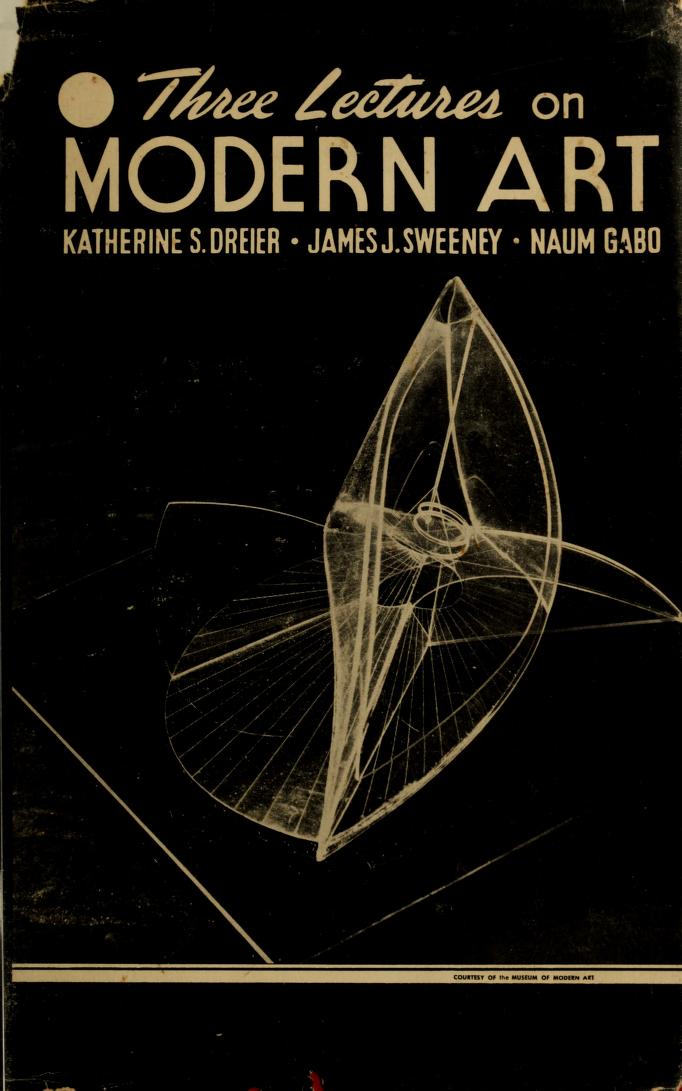Katherine S. Dreier, James Johnson Sweeney, Naum Gabo: Three Lectures on Modern Art (1949)
Filed under book | Tags: · abstract art, art, art criticism, avant-garde, constructivism, painting

“These lectures by three brilliant leaders in Modern Art were delivered at Yale University under the auspices of the Thomas Rutherford Trowbridge Art Lecture Foundation.
These three lectures deal with the founding of the Société Anonyme; Museum of Modern Art; 1920, which was organized by Katherine S. Dreier, Marcel Duchamp and Man Ray to bring clarity and understanding to the confusion which the many new forms of expression in art brought over by the Armory Exhibition in 1913 had caused.”
The lectures include “Intrinsic Significance” in Modern Art by Katherine S. Dreier. Modern Art and Tradition by James Johnson Sweeney, and A Retrospective View of Constructive Art by Naum Gabo.
Foreword by Dean Charles Sawyer
Publisher The Philosophical Library, 1949
91 pages
PDF
Internet Archive (multiple formats)
Gilles Deleuze: Francis Bacon: The Logic of Sensation (1981–) [EN, ES, PT, HU]
Filed under book | Tags: · art, art criticism, body without organs, diagram, painting, philosophy

Gilles Deleuze was one of the most influential and revolutionary philosophers of the twentieth century. Francis Bacon: The Logic of Sensation is his long-awaited work on Bacon, widely regarded as one of the most radical painters of the twentieth century. The book presents a deep engagement with Bacon’s work and the nature of art. Deleuze analyzes the distinctive innovations that came to mark Bacon’s style: the isolation of the figure, the violation deformations of the flesh, the complex use of color, the method of chance, and the use of the triptych form. Along the way, Deleuze introduces a number of his own famous concepts, such as the ‘body without organs’ and the ‘diagram,’ and contrasts his own approach to painting with that of both the phenomenological and the art historical traditions. Deleuze links Bacon’s work to Cezanne’s notion of a ‘logic’ of sensation, which reaches its summit in color and the ‘coloring sensation.’ Investigating this logic, Deleuze explores Bacon’s crucial relation to past painters such as Velasquez, Cezanne, and Soutine, as well as Bacon’s rejection of expressionism and abstract painting. Long awaited in translation, Francis Bacon is destined to become a classic philosophical reflection on the nature of painting.
First published as Francis Bacon: Logique de la Sensation, Editions de la Difference, Editions du Seuil, France, 1981
Translated by Daniel W. Smith
Publisher Continuum International Publishing Group, London/New York, 2003
ISBN 0826466478, 9780826466471
228 pages
publisher (EN)
google books (EN)
Francis Bacon: The Logic of Sensation (English, trans. Daniel W. Smith, 2003)
Francis Bacon: Lógica de la sensación (Spanish, trans. Ernesto Hernández B. Revista “Sé cauto”, 1984)
Francis Bacon: Lógica Da Sensacão (Portuguese, trans. Silvio Ferraz and Annita Costa Malufe)
Francis Bacon: Az érzet logikája (Hungarian, undated, unpaginated, added on 2013-9-26)
Charity Scribner: Requiem for Communism (2003)
Filed under book | Tags: · art, art criticism, art history, literature, memory, post-communism, socialism

“In Requiem for Communism Charity Scribner examines the politics of memory in postindustrial literature and art. Writers and artists from Europe’s second world have responded to the last socialist crisis with works that range from sober description to melancholic fixation. This book is the first survey of this cultural field.
Today, as the cultures of Eastern and Western Europe merge into the Infobahn of late capitalism, the second world is being left behind. The European Union has pronounced obsolete the structures that once defined and linked industrial cities from Manchester to Karl-Marx-Stadt—the decaying factories and working collectives, the wasted ideals of state socialism and the welfare state. Marxist exponents of global empire see this historical turn as an occasion to eulogize “the lightness and joy of being communist.” But for many writers and artists on the left, the fallout of the last century’s socialist crisis calls for an elegy. This regret has prompted a proliferation of literary texts and artworks, as well as a boom in museum exhibitions that race to curate the wreckage of socialism and its industrial remnants. The best of these works do not take us back to the factory. Rather they look for something to take out of it: the intractable moments of solidarity among men and women that did not square with the market or the plan.
Requiem for Communism explores a selection of signal works. They include John Berger’s narrative trilogy Into Their Labors; Documenta, the German platform for contemporary art and ideas; Krzysztof Kieslowski’s cinema of mourning and Andrzej Wajda’s filmed chronicles of the Solidarity movement; the art of Joseph Beuys and Rachel Whiteread; the novels of Christa Wolf; and Leslie Kaplan’s antinostalgic memoir of women’s material labor in France. Sorting among the ruins of the second world, the critical minds of contemporary Europe aim to salvage both the remains of socialist ideals and the latent feminist potential that attended them.”
Publisher MIT Press, 2003
ISBN 0262194880, 9780262194884
245 pages
Review (Mary A. Nicholas, The Slavic and East European Journal, 2004)
Review (ArtMargins, Hans J. Rindisbacher and Larissa Rudova, 2004)

